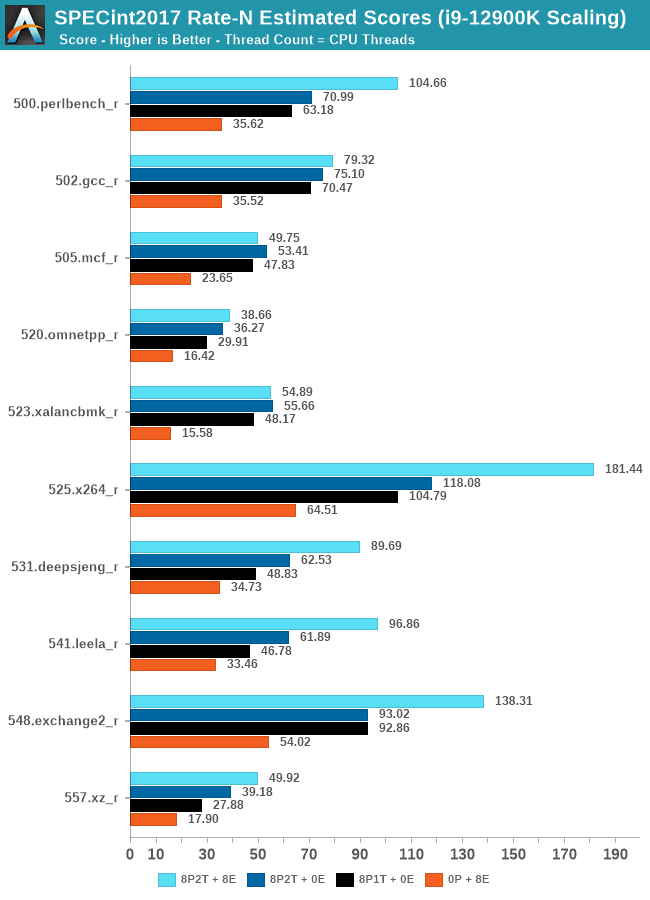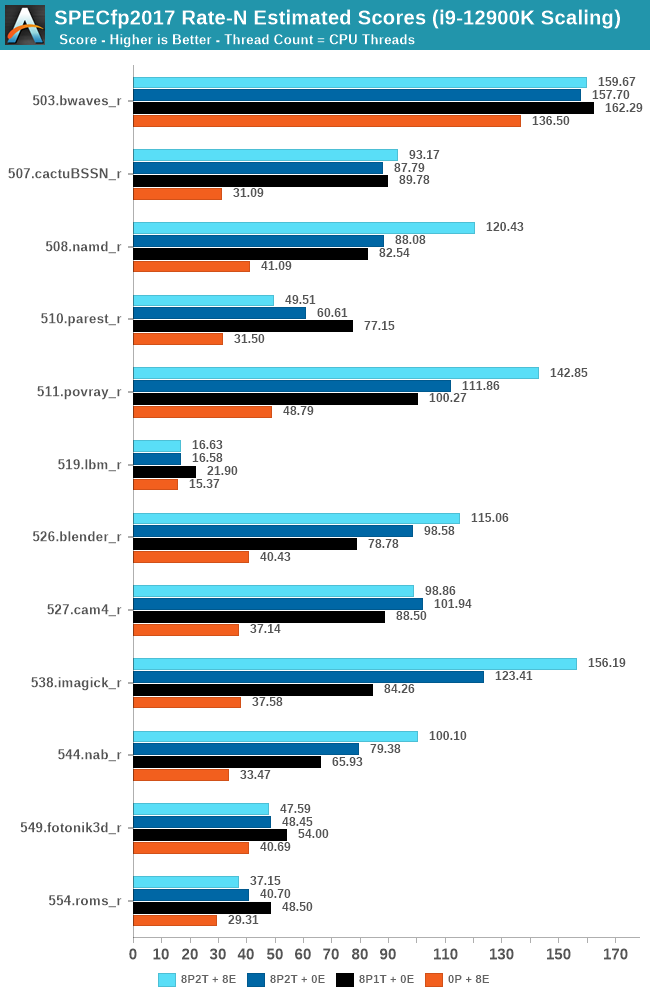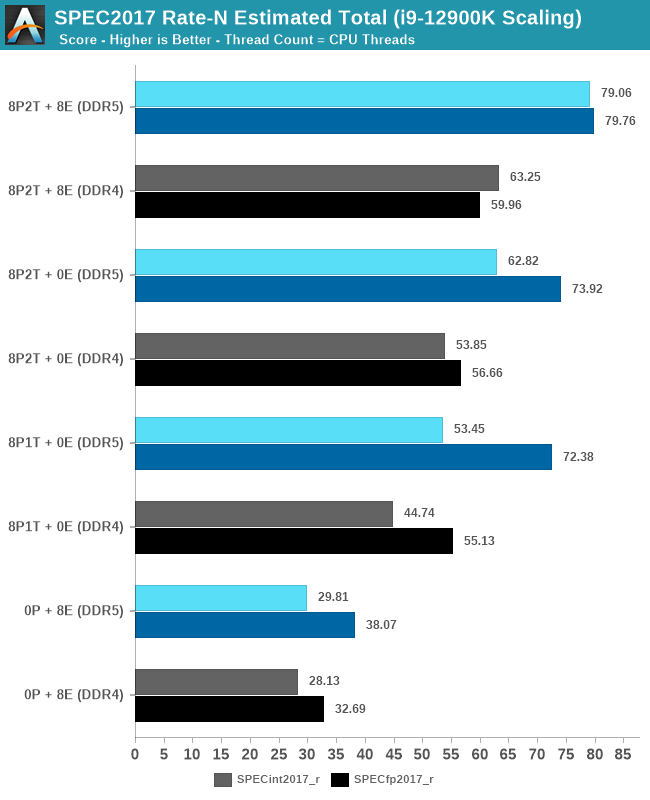The Intel 12th Gen Core i9-12900K Review: Hybrid Performance Brings Hybrid Complexity
by Dr. Ian Cutress & Andrei Frumusanu on November 4, 2021 9:00 AM ESTCPU Tests: SPEC MT Performance - P and E-Core Scaling
Update Nov 6th:
We’ve finished our MT breakdown for the platform, investigating the various combination of cores and memory configurations for Alder Lake and the i9-12900K. We're posting the detailed scores for the DDR5 results, following up the aggregate results for DDR4 as well.
The results here solely cover the i9-12900K and various combinations of MT performance, such as 8 E-cores, 8 P-cores with 1T as well as 2T, and the full 24T 8P2T+8E scenario. The results here were done on Linux due to easier way to set affinities to the various cores, and they’re not completely comparable to the WSL results on the previous page, however should be within small margins of error for most tests.

In the integer suite, the E-cores are quite powerful, reaching scores of around 50% of the 8P2T results, or more.
Many of the more core-bound workloads appear to very much enjoy just having more cores added to the suite, and these are also the workloads that have the largest gains in terms of gaining performance when we add 8 E-cores on top of the 8P2T results.
Workloads that are more cache-heavy, or rely on memory bandwidth, both shared resources on the chip, don’t scale too well at the top-end of things when adding the 8 E-cores. Most surprising to me was the 502.gcc_r result which barely saw any improvement with the added 8 E-cores.
More memory-bound workloads such as 520.omnetpp or 505.mcf are not surprising to see them not scale with the added E-cores – mcf even seeing a performance regression as the added cores mean more memory contention on the L3 and memory controllers.

In the FP suite, the E-cores more clearly showcase a lower % of performance relative to the P-cores, and this makes sense given their design. Only few more compute-bound tests, such as 508.namd, 511.povray, or 538.imagick see larger contributions of the E-cores when they’re added in on top of the P-cores.
The FP suite also has a lot more memory-hungry workload. When it comes to DRAM bandwidth, having either E-cores or P-cores doesn’t matter much for the workload, as it’s the memory which is bottlenecked. Here, the E-cores are able to achieve extremely large performance figures compared to the P-cores. 503.bwaves and 519.lbm for example are pure DRAM bandwidth limited, and using the E-cores in MT scenarios allows for similar performance to the P-cores, however at only 35-40W package power, versus 110-125W for the P-cores result set.
Some of these workloads also see regressions in performance when adding in more cores or threads, as it just means more memory traffic contention on the chip, such as seen in the 8P2T+8E, 8P2T regressions over the 8P1T results.

What’s most interesting here is the scaling of performance and the attribution between the P-cores and the E-cores. Focusing on the DDR5 set, the 8 E-cores are able to provide around 52-55% of the performance of 8 P-cores without SMT, and 47-51% of the P-cores with SMT. At first glance this could be argued that the 8P+8E setup can be somewhat similar to a 12P setup in MT performance, however the combined performance of both clusters only raises the MT scores by respectively 25% in the integer suite, and 5% in the FP suite, as we are hitting near package power limits with just 8P2T, and there’s diminishing returns on performance given the shared L3. What the E-cores do seem to allow the system is to allows to reduce every-day average power usage and increase the efficiency of the socket, as less P-cores need to be active at any one time.










474 Comments
View All Comments
adamxpeter - Friday, November 5, 2021 - link
Very poetic post.bananaforscale - Friday, November 5, 2021 - link
Seems we're actually getting a Zen 3 refresh early next year. Alder Lake's lead also decreases with DDR4, gaming above 1080p (so basically anyone who would buy a 12900K for a gaming rig), it uses more power and with DDR5 you pay extra for memory.Yeah, Alder Lake has some advantages. Not sure I'd call it a better overall package at the moment.
madseven7 - Saturday, November 6, 2021 - link
Intel is back at the cost of power. AMD at that power will destroy Intel. Intel basically said screw TDP.Qasar - Saturday, November 6, 2021 - link
intel has been saying that for 2-3 years now, its the only way their chips can be competitive with zen 2 and 3Maverick009 - Sunday, November 7, 2021 - link
They really haven't screwed up as you would like to think. I do believe AMD was thrown off some by the unexpected performance in Hybrid design. They still do trade blows between some games, multi-threaded software, and on applications that are just not optimized for Alder Lake.What I have noticed though in the days since Alder Lake's NDA went up and reviews came out, is leaks to AMD's next gen Zen CPUs have begun to trinkle out a little more than usual. Yes we have Zen 4 on the way, which will pave the way for DDR5 and PCIe Gen5 along with an uplift in IPC. However the real secret sauce may be in Zen 4D as the platform to build a heavily multi-threaded core package along with SMT enabled, and then Zen 5. The big picture, is AMD's version of a Hybrid CPU may include a combination of Zen 4D big cores and Zen 5 Bigger cores. The Zen 4D are said to possibly carry as many as 16 cores per chiplet, too, so it would speak to a possible heavily multi-threaded efficient CPU, while sacrificing a little bit of single threaded performance to achieve it. The timeframe would also put the new Hybrid CPU on a collision course to battle Raptor Lake.
For once the CPU market has gotten interesting again, and the consumer ultimately wins here.
NikosD - Monday, November 8, 2021 - link
@reviewersSince AVX-512 is working on ADL, it would be useful to test the AVX-512 vs AVX2 power consumption of ADL by running POVRAY using P-cores only and compare that maximum AVX2 power consumption to AVX-512 max power consumption using 3DPM.
Because max 272W power consumption of POVRAY as reported, includes 48W from E-cores too.
mode_13h - Tuesday, November 9, 2021 - link
> it would be useful to test the AVX-512 vs AVX2 power consumption of ADL by running POVRAYI'm not sure of POV-Ray is the best way to stress AVX-512.
NikosD - Wednesday, November 10, 2021 - link
They have already tested max power consumption of AVX-512 using 3DPM.I just asked to test POVRAY using P-cores only, for max power consumption of AVX2 in order to compare with 3DPM.
usernametaken76 - Monday, November 8, 2021 - link
lolxhris4747 - Tuesday, November 9, 2021 - link
They did not take the performance crown gaming is almost tied overall mt is a mixed bag hopefully they use pbo which gives about 27k-30k on c23